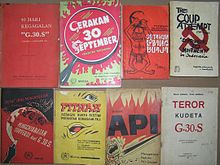
Indonesian mass killings of 1965–66
Anti-communist killings and unrest in Indonesia following a coup d'état attempt / From Wikipedia, the free encyclopedia
Dear Wikiwand AI, let's keep it short by simply answering these key questions:
Can you list the top facts and stats about Indonesian mass killings of 1965–66?
Summarize this article for a 10 years old
Large-scale killings and civil unrest primarily targeting members of the Communist Party (PKI) were carried out in Indonesia from 1965 to 1966. Other affected groups included alleged communist sympathisers, Gerwani women, trade unionists,[14] ethnic Javanese Abangan,[1] ethnic Chinese, atheists, so-called "unbelievers", and alleged leftists in general. According to the most widely published estimates at least 500,000 to 1.2 million people were killed,[3]: 3 [4][5][7] with some estimates going as high as two to three million.[15][16] The atrocities, sometimes described as a genocide[17][2][3] or politicide,[18][19] were instigated by the Indonesian Army under Suharto. Research and declassified documents demonstrate the Indonesian authorities received support from foreign countries such as the United States and the United Kingdom.[20][21]: 157 [22][23][24][25]
| Indonesian mass killings of 1965–66 | |
|---|---|
| Part of Cold War in Asia and Transition to the New Order | |
 Anti-PKI propaganda literature | |
| Location | Indonesia |
| Date | 1965–1966 |
| Target | PKI members, alleged PKI sympathisers, Gerwani members, ethnic Javanese Abangan,[1] atheists, and ethnic Chinese[2] |
Attack type | Politicide, mass murder, genocide[2] |
| Deaths | 500,000[3]: 3 –1,000,000+[3]: 3 [4][5][6][7] |
| Perpetrators | Indonesian Army and various death squads, supported by the United States, the United Kingdom and other Western governments[8][9][10][11][12][13] |
The killings began as an anti-communist purge following a controversial attempted coup d'état by the 30 September Movement. It was a pivotal event in the transition to the "New Order" and the elimination of PKI as a political force, with impacts on the global Cold War.[26] The upheavals led to the fall of President Sukarno and the commencement of Suharto's three-decade authoritarian presidency.
The abortive coup attempt released pent-up communal hatreds in Indonesia; these were fanned by the Indonesian Army, which quickly blamed the PKI. Additionally, the intelligence agencies of the United States, United Kingdom and Australia engaged in black propaganda campaigns against Indonesian communists. During the Cold War, the United States, its government, and its Western allies had the goal of halting the spread of communism and bringing countries into the sphere of Western Bloc influence. Britain had additional reasons for seeking Sukarno's removal, as his government was involved in an undeclared war with the neighbouring Federation of Malaya, a Commonwealth federation of former British colonies.
Communists were purged from political, social, and military life, and the PKI itself was disbanded and banned. Mass killings began in October 1965, in the weeks following the coup attempt, and reached their peak over the remainder of the year before subsiding in the early months of 1966. They started in the capital, Jakarta, and spread to Central and East Java, and later Bali. Thousands of local vigilantes and Army units killed actual and alleged PKI members. Killings occurred across the country, with the most intense in the PKI strongholds of Central Java, East Java, Bali, and northern Sumatra.
It is possible that over one million suspected PKI members and alleged communist sympathizers were imprisoned at one time or another. Sukarno's balancing act of "Nasakom" (nationalism, religion, and communism) unravelled. His most significant pillar of support, the PKI, was effectively eliminated by the other two pillars—the Army and political Islam; and the Army was on the way to gaining unchallenged power. In March 1967, Sukarno was stripped of his remaining authority by Indonesia's provisional parliament, and Suharto was named Acting President. In March 1968, Suharto was formally elected president.
The killings are skipped over in most Indonesian history textbooks and have received little attention by Indonesians due to their suppression under the Suharto regime, as well as receiving little international attention. The search for satisfactory explanations for the scale and frenzy of the violence has challenged scholars from all ideological perspectives. The possibility of returning to similar upheavals is cited as a factor in the "New Order" administration's political conservatism and tight control of the political system. Vigilance and stigma against a perceived communist threat remained a hallmark of Suharto's doctrine, and it is still in force even today.[27]
Despite a consensus at the highest levels of the U.S. and British governments that it would be necessary "to liquidate Sukarno", as related in a Central Intelligence Agency (CIA) memorandum from 1962,[28] and the existence of extensive contacts between anti-communist army officers and the U.S. military establishment – training of over 1,200 officers, "including senior military figures", and providing weapons and economic assistance[29][30] – the CIA denied active involvement in the killings. Declassified U.S. documents in 2017 revealed that the U.S. government had detailed knowledge of the mass killings from the beginning and was supportive of the actions of the Indonesian Army.[9][22][31] U.S. complicity in the killings, which included providing extensive lists of PKI officials to Indonesian death squads,[37] has previously been established by historians and journalists.[22][26]
A top-secret CIA report from 1968 stated that the massacres "rank as one of the worst mass murders of the 20th century, along with the Soviet purges of the 1930s, the Nazi mass murders during the Second World War, and the Maoist bloodbath of the early 1950s."[38][39]
